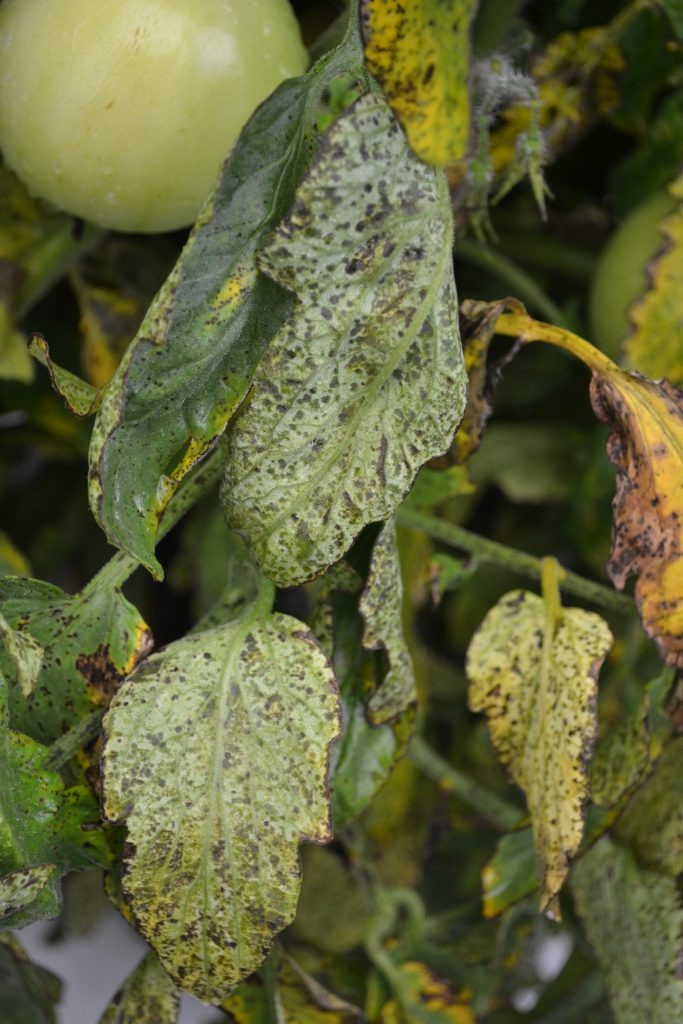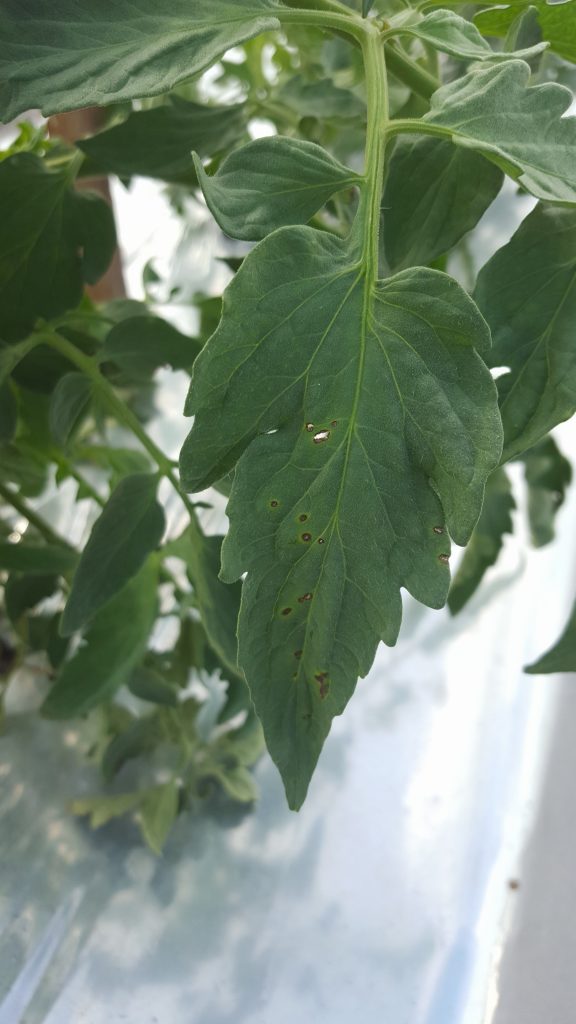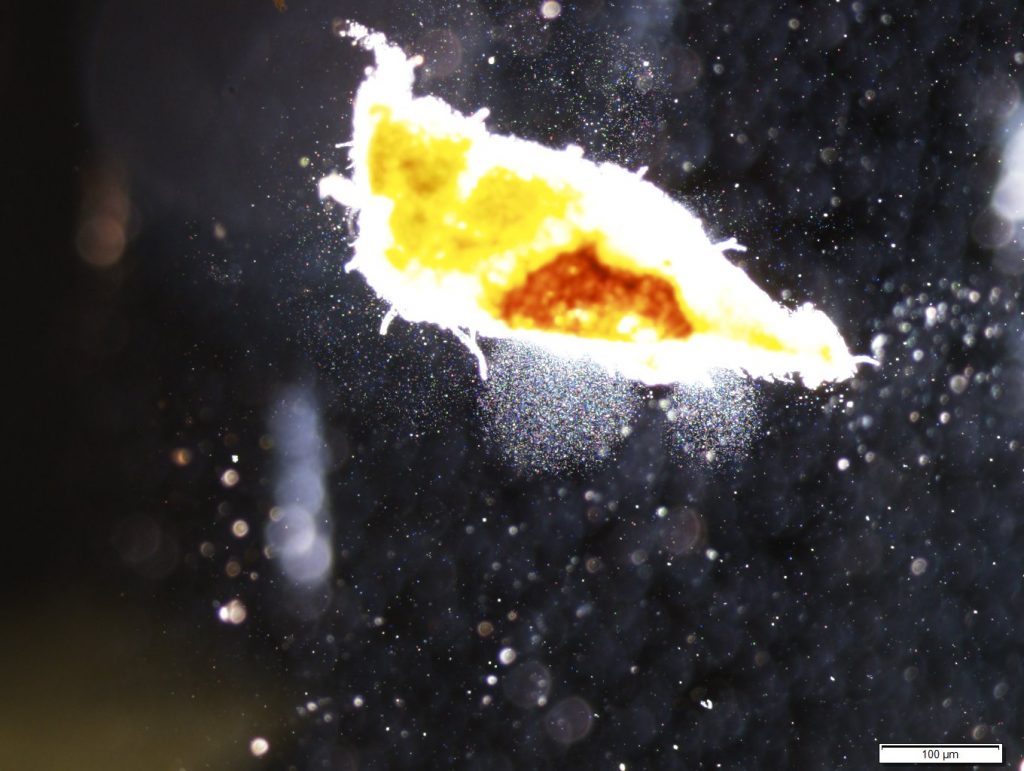By Gary Vallad
Few diseases present a persistent year-to-year challenge to tomato production like bacterial spot. Under ideal conditions, the disease can cause massive defoliation leading to yield losses through lost photosynthetic capacity and fruit exposure to the elements. This increases sunscald and raincheck as well as direct fruit infection by the pathogen.

DISEASE SPREAD AND SYMPTOMS
Xanthomonas perforans is the principal cause of bacterial spot in the Southeast,
although three additional Xanthomonas
species also cause bacterial spot around the globe. Disease development is
favored by temperatures between 75 and 86 F and high relative humidity. Rain
and free moisture are essential for pathogen spread. As such, the bacterium is easily
dispersed in water through splashing rain drops and manually through the
handling of wet plants. Concentrated tomato acreage can expedite pathogen movement
between fields and farm operations through wind-driven rain events and typical
farm activities (planting, pruning, staking and tying).
Initial bacterial spot symptoms consist of water-soaked leaf tissue, which appears roughly four to seven days after plant exposure. These symptoms are easiest to observe on the underside of leaves during the early morning hours when the relative humidity is highest (Figure 1).

After an additional three to five days, symptoms progress further leading to the development of small (2 to 3 millimeters) necrotic lesions and shot-hole lesions on infected foliage (Figure 2). Early in the morning, or when relative humidity is high, these lesions will often have a greasy appearance due to the massive number of bacteria present within the lesion. The immense inoculum potential of a single lesion is best understood when viewed under a microscope, as tens of millions of bacterial cells stream out into water (Figure 3).
Each bacterial cell can initiate a new infection through natural leaf openings (stomates and hydathodes) and through wounds (such as wind-driven sand, insect damage and mechanical damage). All vegetative parts of the plant, including stems, flowers and fruit, are susceptible to infection. Severe infections of flower tissues can lead to bloom drop, or even the infection of young fruit. In the case of seed production, infection can lead to contaminated seed. The seedborne nature of this bacterial pathogen likely accounts for its global spread of new strains that have hindered resistance breeding efforts in tomato.
Transplants can also act as long-distance carriers for the pathogen, as they are typically grown with overhead irrigation that creates conditions favorable for bacterial spot. Studies conducted at the University of Florida Institute of Food and Agricultural Sciences (UF/IFAS) Gulf Coast Research and Education Center (GCREC) and at a commercial transplant operation focused on the spread of bacterial spot during transplant production.
These trials demonstrated that the bacterial spot pathogen could easily move an inch to nearly a foot a day, depending on environment (temperature and relative humidity) and the use of overhead irrigation. Follow-up studies demonstrated this rapid movement is facilitated by bacteria in water aerosols produced by overhead irrigation systems.
Transplant houses typically use adjustable side walls to improve airflow and control temperature. Growers often attribute bacterial spot outbreaks along the outside edge of a house as evidence of inoculum entering from the outside. However, research findings indicate that the enhanced air flow near the side wall and use of extra or larger nozzles to improve watering of trays near the side wall facilitate greater aerosol production and increased movement of the pathogen.
TIPS FOR TRANSPLANT GROWERS
Many transplant operations
rogue diseased plants to contain disease. However, with a four- to 12-day lag
between infection and the appearance of bacterial spot symptoms, it can be difficult
to judge how many plants or transplant trays to rogue. This is especially true for
transplants produced in the summer when conditions favor rapid disease
development and pathogen movement. Here are some simple guidelines transplant growers
can follow:
- Scout daily for disease, especially areas within the transplant house that remain wet or near the outside wall. Early morning is the best time to observe symptoms of water soaking. Be sure to wear gloves and wash hands to minimize pathogen movement.
- Manage watering to allow plants to dry quickly.
- Always rogue whole trays containing symptomatic plants. The spread of bacterial spot increases with temperature and relative humidity within the transplant facility.
- To be effective, additional trays (in all directions) need to be rogued around the initial tray that was infected to compensate for the increased pathogen movement. Rogue at least one to two trays when average day temperatures range from 75 to 84 F. Temperatures exceeding 84 F may require rogueing of three to four trays, which is impractical for most transplant operations and may still not be enough to eliminate the pathogen.
These are generalized recommendations based on controlled movement studies using standard 128-cell transplant trays on a rail system and a single watering with an overhead boom. The use of higher plant densities and increased watering would likely require more aggressive rogueing.
Irrigation changes, such as reduced water pressure and using nozzles that produce larger water droplet sizes to reduce aerosol production should reduce pathogen spread. The use of ebb-and-flow systems that facilitate watering from the bottom of trays rather than overhead would be even more ideal.
TESTING PRODUCT PERFORMANCE
In addition to
rogueing, transplant operations still rely on copper for managing bacterial spot.
The prevalence of copper-tolerant X.
perforans strains greatly reduces the efficacy of copper-based bactericides.
Replicated trials at GCREC evaluated 18 various alternatives alone and in combinations
for managing bacterial spot on tomato transplants.
Two commercial products stood out in performance. Actigard (acibenzolar-S-methyl) and Cueva (copper octanoate) consistently performed better in the management of bacterial spot over standard applications of Kocide 3000 (copper hydroxide) in repeated trials alone or when combined with other products. Actigard was applied as a single foliar application to the first true leaves. Cueva was applied beginning at the first true leaves and repeated weekly for four weeks.
TAKE-AWAY MESSAGE
Making preventive applications is critical for successful disease management,
and this is especially true for bacterial spot. However, the combined use of
effective foliar products in tandem with rogueing and other management
practices should effectively manage bacterial spot in transplant production and
reduce subsequent pathogen introduction to the field where few effective alternatives
are available.
Gary Vallad is an associate professor at the UF/IFAS GCREC in Wimauma.
This article was featured in the June issue of VSCNews magazine. To receive future issues of VSCNews magazine, click here.
Share this Post










